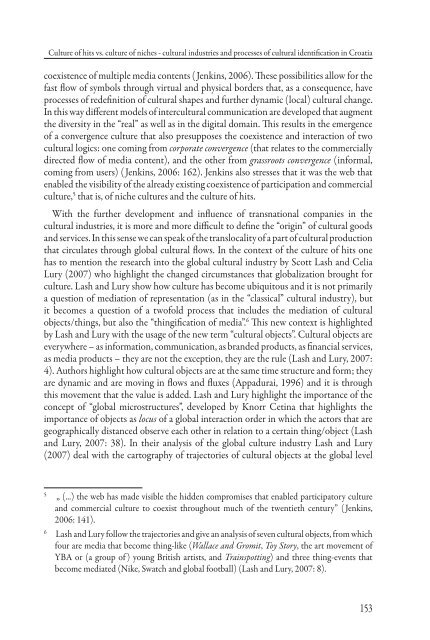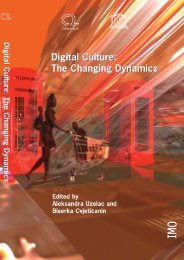free download in pdf format - Culturelink Network
free download in pdf format - Culturelink Network
free download in pdf format - Culturelink Network
You also want an ePaper? Increase the reach of your titles
YUMPU automatically turns print PDFs into web optimized ePapers that Google loves.
Culture of hits vs. culture of niches - cultural <strong>in</strong>dustries and processes of cultural identifi cation <strong>in</strong> Croatia<br />
coexistence of multiple media contents ( Jenk<strong>in</strong>s, 2006). Th ese possibilities allow for the<br />
fast fl ow of symbols through virtual and physical borders that, as a consequence, have<br />
processes of redefi nition of cultural shapes and further dynamic (local) cultural change.<br />
In this way diff erent models of <strong>in</strong>tercultural communication are developed that augment<br />
the diversity <strong>in</strong> the “real” as well as <strong>in</strong> the digital doma<strong>in</strong>. Th is results <strong>in</strong> the emergence<br />
of a convergence culture that also presupposes the coexistence and <strong>in</strong>teraction of two<br />
cultural logics: one com<strong>in</strong>g from corporate convergence (that relates to the commercially<br />
directed fl ow of media content), and the other from grassroots convergence (<strong>in</strong>formal,<br />
com<strong>in</strong>g from users) ( Jenk<strong>in</strong>s, 2006: 162). Jenk<strong>in</strong>s also stresses that it was the web that<br />
enabled the visibility of the already exist<strong>in</strong>g coexistence of participation and commercial<br />
culture, 5 that is, of niche cultures and the culture of hits.<br />
With the further development and <strong>in</strong>fl uence of transnational companies <strong>in</strong> the<br />
cultural <strong>in</strong>dustries, it is more and more diffi cult to defi ne the “orig<strong>in</strong>” of cultural goods<br />
and services. In this sense we can speak of the translocality of a part of cultural production<br />
that circulates through global cultural fl ows. In the context of the culture of hits one<br />
has to mention the research <strong>in</strong>to the global cultural <strong>in</strong>dustry by Scott Lash and Celia<br />
Lury (2007) who highlight the changed circumstances that globalization brought for<br />
culture. Lash and Lury show how culture has become ubiquitous and it is not primarily<br />
a question of mediation of representation (as <strong>in</strong> the “classical” cultural <strong>in</strong>dustry), but<br />
it becomes a question of a twofold process that <strong>in</strong>cludes the mediation of cultural<br />
objects/th<strong>in</strong>gs, but also the “th<strong>in</strong>gifi cation of media”. 6 Th is new context is highlighted<br />
by Lash and Lury with the usage of the new term “cultural objects”. Cultural objects are<br />
everywhere – as <strong>in</strong><strong>format</strong>ion, communication, as branded products, as fi nancial services,<br />
as media products – they are not the exception, they are the rule (Lash and Lury, 2007:<br />
4). Authors highlight how cultural objects are at the same time structure and form; they<br />
are dynamic and are mov<strong>in</strong>g <strong>in</strong> fl ows and fl uxes (Appadurai, 1996) and it is through<br />
this movement that the value is added. Lash and Lury highlight the importance of the<br />
concept of “global microstructures”, developed by Knorr Cet<strong>in</strong>a that highlights the<br />
importance of objects as locus of a global <strong>in</strong>teraction order <strong>in</strong> which the actors that are<br />
geographically distanced observe each other <strong>in</strong> relation to a certa<strong>in</strong> th<strong>in</strong>g/object (Lash<br />
and Lury, 2007: 38). In their analysis of the global culture <strong>in</strong>dustry Lash and Lury<br />
(2007) deal with the cartography of trajectories of cultural objects at the global level<br />
5 „ (...) the web has made visible the hidden compromises that enabled participatory culture<br />
and commercial culture to coexist throughout much of the twentieth century” ( Jenk<strong>in</strong>s,<br />
2006: 141).<br />
6 Lash and Lury follow the trajectories and give an analysis of seven cultural objects, from which<br />
four are media that become th<strong>in</strong>g-like (Wallace and Gromit, Toy Story, the art movement of<br />
YBA or (a group of ) young British artists, and Tra<strong>in</strong>spott<strong>in</strong>g) and three th<strong>in</strong>g-events that<br />
become mediated (Nike, Swatch and global football) (Lash and Lury, 2007: 8).<br />
153



